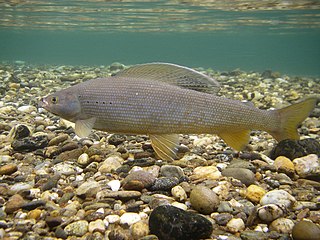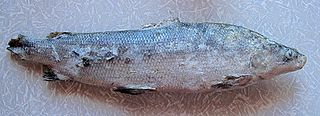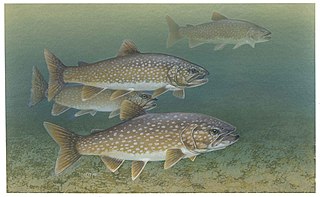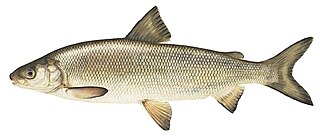 W
WThe Alaska blackfish is a species of freshwater fish in the esocid family (Esocidae) of order Esociformes. It inhabits Arctic regions of Alaska as well as Siberia and the Bering Sea islands.
 W
WThe Alaska whitefish is a species of whitefish in the family Salmonidae. It is found in parts of northwestern North America, where it occurs only in small and large rivers, and rarely in lakes. The maximum length recorded for this species is 56.0 cm (22.0 in).
 W
WArctic cisco is an anadromous species of freshwater whitefish that inhabits the Arctic parts of Siberia, Alaska and Canada. It has a close freshwater relative in several lakes of Ireland, known as the pollan, alternatively regarded as conspecific with it, or as a distinct species.
 W
WArctic grayling is a species of freshwater fish in the salmon family Salmonidae. T. arcticus is widespread throughout the Arctic and Pacific drainages in Canada, Alaska, and Siberia, as well as the upper Missouri River drainage in Montana. In the U.S. state of Arizona, an introduced population is found in the Lee Valley and other lakes in the White Mountains. They were also stocked at Toppings Lake by the Teton Range and in various lakes in the high Uinta Mountains in Utah, as well as various alpine lakes of the Boulder Mountain chain in central Idaho.
 W
WThe Arctic lamprey, also known as the Japanese river lamprey or Japanese lampern, is a species of lamprey, a jawless fish in the order Petromyzontiformes. It inhabits coastal freshwater habitat types in the Arctic. Some populations are anadromous, spending part of their lives in the ocean. It is the most common and widespread lamprey in the Arctic region.
 W
WThe Bering cisco or Lauretta whitefish is a freshwater whitefish found in Alaska and part of Russia. It is often considered to be the same species as the more common Arctic cisco.
 W
WThe broad whitefish is a freshwater whitefish species. Dark silvery in colour, and like a herring in its shape, its distinctive features include a convex head, short gill rakers, and a mild overbite. It is found in the Arctic-draining streams, lakes, and rivers of far eastern Russia and North America. Its prey includes larval insects, snails, and shellfish. It is eaten by humans and brown bears.
 W
WThe burbot is the only gadiform (cod-like) freshwater fish. It is also known as bubbot, mariah, freshwater ling, the lawyer, coney-fish, lingcod, freshwater cusk, and eelpout. The species is closely related to the marine common ling and the cusk. It is the only member of the genus Lota. For some time of the year, the burbot lives under ice, and it requires frigid temperatures to breed.
 W
WThe Arctic char or Arctic charr is a cold-water fish in the family Salmonidae, native to alpine lakes and arctic and subarctic coastal waters. Its distribution is circumpolar. It spawns in fresh water and populations can be lacustrine, riverine or anadromous, where they return from the ocean to their fresh water birth rivers to spawn. No other freshwater fish is found as far north; it is, for instance, the only fish species in Lake Hazen on Ellesmere Island in the Canadian Arctic. It is one of the rarest fish species in Britain and Ireland, found mainly in deep, cold, glacial lakes, and is at risk from acidification. In other parts of its range, such as the Nordic countries, it is much more common, and is fished extensively. In Siberia, it is known as golets and it has been introduced in lakes where it sometimes threatens less hardy endemic species, such as the small-mouth char and the long-finned char in Elgygytgyn Lake.
 W
WThe ciscoes are salmonid fish of the genus Coregonus that differ from other members of the genus in having upper and lower jaws of approximately equal length and high gill raker counts. These species have been the focus of much study recently, as researchers have sought to determine the relationships among species that appear to have evolved very recently. The term cisco is also specifically used of the North American species Coregonus artedi, also known as lake herring.
 W
WCoregonus sardinella, known as the sardine cisco, and in North America as the least cisco, is a fresh- and brackishwater species of salmonid fish that inhabits rivers, estuaries and coastal waters of the marginal seas of the Arctic Basin, as well as some large lakes of those areas.
 W
WThe humpback whitefish, also referred to as the bottom whitefish, the Arctic whitefish or the pidschian, is a species of freshwater whitefish with a northern distribution. It is one of the members in the broader common whitefish complex, or the Coregonus clupeaformis complex. This fish lives in estuaries and brackish water near river mouths, in deltas and in slowly running rivers, in large lakes with tributaries, and floodplain lakes. It can migrate long distances upriver for spawning.
 W
WThe longnose sucker is a species of cypriniform freshwater fish in the family Catostomidae. It is native to North America from the northern United States to the top of the continent. It is also found in Russia in rivers of eastern Siberia, and thus one of only two species of sucker native to Asia.
 W
WThe Montana Arctic grayling is a North American freshwater fish in the salmon family Salmonidae. The Montana Arctic grayling, native to the upper Missouri River basin in Montana and Wyoming, is a disjunct population or subspecies of the more widespread Arctic grayling. It occurs in fluvial and adfluvial, lacustrine forms. The Montana grayling is a species of special concern in Montana and had candidate status for listing under the national Endangered Species Act. It underwent a comprehensive status review by the U.S. Fish and Wildlife Service, which in 2014 decided not to list it as threatened or endangered. Current surviving native populations in the Big Hole River and Red Rock River drainages represent approximately four percent of the subspecies' historical range.
 W
WThe muksun (Coregonus muksun) is a type of whitefish widespread in the Siberian Arctic waters. It is mostly found in the freshened areas of the Kara and Laptev Seas and up the major rivers, as well as in Lake Taymyr.
 W
WStenodus nelma, known alternatively as the nelma, sheefish, inconnu or connie, is a commercial species of freshwater whitefish in the family Salmonidae. It is widespread in the Arctic rivers from the Kola Peninsula eastward across Siberia to the Anadyr River and also in the North American basins of the Yukon River and Mackenzie River.
 W
WThe northern pike is a species of carnivorous fish of the genus Esox. They are typical of brackish and fresh waters of the Northern Hemisphere. They are known simply as a pike in Britain, Ireland, and most of Eastern Europe, Canada and the United States.
 W
WThe pond smelt is a freshwater species of smelt that inhabits the Arctic.
 W
WThe rainbow smelt is a North American species of fish of the family Osmeridae. It was introduced to the Great Lakes, and from there has made its way to various other places. Walleye, trout, and other larger fish prey on these smelt. The rainbow smelt prefer juvenile ciscoes, zooplankton such as calanoid copepods, and other small organisms, but are aggressive and will eat almost any fish they find. They are anadromous spring spawners and prefer clean streams with light flow and light siltation. The rainbow smelt face several barriers. They are weak swimmers and cannot overcome most fish ladders. This prevents them from making it past the dams to the headwater streams where they spawn. The rise in erosion and dams helped to decimate the smelt population in the 1980s. There are currently plans to try to reduce damming and to help control erosion. With current efforts to reduce the human impact on this and many other affected species the population is back on the rise.
 W
WThe Atlantic salmon is a species of ray-finned fish in the family Salmonidae which is the largest salmon and can grow up to a meter in length. It is found in the northern Atlantic Ocean and in rivers that flow into this ocean. Most populations of this fish species are anadromous, hatching in streams and rivers but moving out to sea as they grow where they mature, after which the adult fish seasonally move upstream again to spawn.
 W
WThe Chinook salmon is the largest species of Pacific salmon as well as the largest in the genus Oncorhynchus. Its common name is derived from the Chinookan peoples. Other vernacular names for the species include king salmon, Quinnat salmon, spring salmon, chrome hog, and Tyee salmon. The scientific species name is based on the Russian common name chavycha (чавыча).
 W
WThe chum salmon is a species of anadromous fish in the salmon family. It is a Pacific salmon, and may also be known as dog salmon or keta salmon, and is often marketed under the name silverbrite salmon. The name chum salmon comes from the Chinook Jargon term tzum, meaning "spotted" or "marked", while keta in the scientific name comes from the Evenki language of Eastern Siberia via Russian.
 W
WPink salmon or humpback salmon is a species of anadromous fish in the salmon family. It is the smallest and most abundant of the Pacific salmon. The scientific species name is based on the Russian common name for this species gorbúša (горбуша), which literally means humpie.
 W
WThe slimy sculpin,, is a freshwater species of fish belonging to the family Cottidae, which is the largest sculpin family. They usually inhabit cold rocky streams or lakes across North America, ranging from the Great Lakes, southeast Minnesota, northeast Iowa, southwest Wisconsin and northeast Canada. Slimy sculpins have also been found roaming the cold streams of eastern Siberia. They are commonly confused with their closely related relatives, Mottled sculpin, and with tubenose gobies who are both freshwater fishes as well. The slimy sculpin is a nocturnal fish that usually spends most of its time on the stream bottom and seeks shelter under rocks and logs, especially during spawning season. When it swims, it sometimes appears to be "hopping" along the bottom because of its inefficient ability to swim. This is partly due to the absence of a swim bladder, which normally gives buoyancy to a fish.
 W
WThe spoonhead sculpin is a North American freshwater fish of the family Cottidae. This species is not as common as its cousin species the mottled sculpin.
 W
WStenodus leucichthys is a species of freshwater whitefish in the family Salmonidae. In the strict sense its natural distribution is restricted to the Caspian Sea basin, and it is known as beloribitsa. The beloribitsa is now considered extinct in the wild, but survives in cultured stocks.
 W
WThe ninespine stickleback, also called the ten-spined stickleback, is a freshwater species of fish in the family Gasterosteidae that inhabits temperate waters. It is widely but locally distributed throughout Eurasia and North America. Despite its name, the number of spines can vary from 8 to 12.
 W
WThe Dolly Varden trout is a species of salmonid native to cold-water tributaries of the Pacific Ocean in Asia and North America. It is in the genus Salvelinus of true chars, which includes 51 recognized species, the most prominent being the brook, lake and bull trout, as well as Arctic char. Although many populations are semi-anadromous, fluvial and lacustrine populations occur throughout its range. It is considered by taxonomists as part of the Salvelinus alpinus or Arctic char complex, as many populations of bull trout, Dolly Varden trout and Arctic char overlap.
 W
WLake trout is a freshwater char living mainly in lakes in northern North America. Other names for it include mackinaw, namaycush, lake char (or charr), touladi, togue, and grey trout. In Lake Superior, it can also be variously known as siscowet, paperbelly and lean. The lake trout is prized both as a game fish and as a food fish. Those caught with dark coloration may be called mud hens.
 W
WThe lake whitefish is a species of freshwater whitefish from North America. Lake whitefish are found throughout much of Canada and parts of the northern United States, including all of the Great Lakes. The lake whitefish is sometimes referred to as a "humpback" fish due to the small size of the head in relation to the length of the body. It is a valuable commercial fish, and also occasionally taken by sport fishermen. Smoked, refrigerated, vacuum-packed lake whitefish fillets are available in North American grocery stores. Other vernacular names used for this fish include Otsego bass, Sault whitefish, gizzard fish, common whitefish, eastern whitefish, Great Lakes whitefish, humpback whitefish, inland whitefish and whitefish.
 W
WThe round whitefish is a freshwater species of fish that is found in lakes from Alaska to New England, including the Great Lakes. It has an olive-brown back with light silvery sides and underside and its length is generally between 9 and 19 inches. They are bottom feeders, feeding mostly on invertebrates, such as crustaceans, insect larvae, and fish eggs. Some other fish species, like white sucker in turn eat their eggs. Lake trout, northern pike and burbot are natural predators. Other common names of the round whitefish are Menominee, pilot fish, frost fish, round-fish, and Menominee whitefish. The common name "round whitefish" is also sometimes used to describe Coregonus huntsmani, a salmonid more commonly known as the Atlantic whitefish.